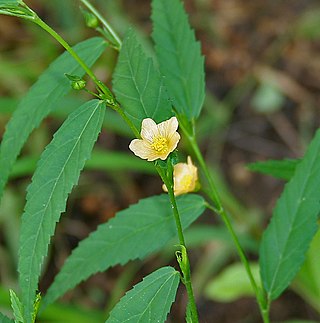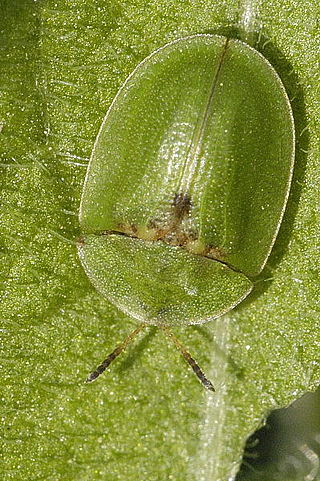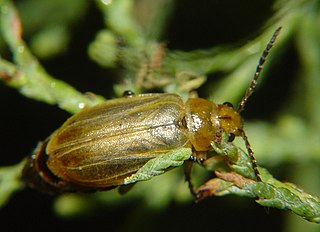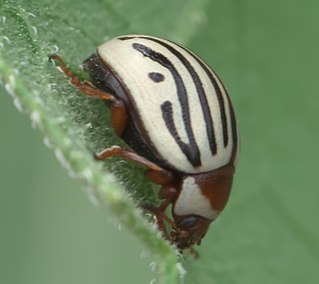
The Colorado potato beetle is a beetle known for being a major pest of potato crops. It is about 10 mm long, with a bright yellow/orange body and five bold brown stripes along the length of each of its elytra. Native to the Rocky Mountains, it spread rapidly in potato crops across America and then Europe from 1859 onwards.

The insects of the beetle family Chrysomelidae are commonly known as leaf beetles, and include over 37,000 species in more than 2,500 genera, making up one of the largest and most commonly encountered of all beetle families. Numerous subfamilies are recognized, but the precise taxonomy and systematics are likely to change with ongoing research.

The light brown apple moth is a leafroller moth belonging to the lepidopteran family Tortricidae.

Siphanta acuta is a species of planthopper in the family Flatidae; this species is native to Australia, but is now found in various other parts of the world. About 10 mm long, they resemble small leaves and are generally found in trees. Its common names are Green Planthopper and Torpedo Bug.

Rhinocyllus conicus is a species of true weevil. It is best known as a controversial agent of biological pest control which has been used against noxious thistles in the genera Carduus, Cirsium, Onopordum, and Silybum.

The hemlock moth, also known as the defoliating hemlock moth or poison hemlock moth, is a nocturnal moth species of the family Depressariidae. Of Palaearctic origin, it was first found in North America in 1973 when it was accidentally introduced. The moth is now widespread throughout the northern half of the United States, southern Canada, northern Europe, and, more recently, New Zealand and Australia. The larval form grows to around 10 mm, while the adults wingspan is between 17 mm and 19 mm.

Sida acuta, the common wireweed, is a species of flowering plant in the mallow family, Malvaceae. It is believed to have originated in Central America, but today has a pantropical distribution and is considered a weed in some areas.

The thistle tortoise beetle is a species of beetle in the subfamily Cassidinae and the genus Cassida. The thistle tortoise beetle can be recognized by its green, rounded back and it can be found on thistle plants in many regions of North America and Europe. The thistle tortioise beetle was first discovered in 1902 in Lévis, Quebec. In 1931, Nellie F. Paterson was the first to document the mature larva. Later, the instar larva of this species was first recorded in 2004 by Jolanta Świętojańska. The thistle tortoise beetle exhibits multiple defense behaviors, such as a flexible shield, providing a barrier against the mandibles of predators, and an excretion that protects the eggs as well.

Diorhabda elongata is a species of leaf beetle known as the Mediterranean tamarisk beetle (MTB) which feeds on tamarisk trees from Portugal and Algeria east to southern Russia. The MTB is used in North America as a biological pest control agent against saltcedar or tamarisk, an invasive species in arid and semi-arid ecosystems.

Diorhabda carinata is a species of leaf beetle known as the larger tamarisk beetle which feeds on tamarisk trees from Ukraine, eastern Turkey and Syria east to northwest China, Kyrgyzstan and Pakistan, extending as far south as southern Iran. It is used in North America as a biological pest control agent against saltcedar or tamarisk, an invasive species in arid and semi-arid ecosystems.

Oxyops vitiosa is a species of weevil in the family Curculionidae. Common names include the melaleuca leaf weevil and the melaleuca snout beetle. It feeds on the leaves and shoots of the broad-leaved paper bark tree, Melaleuca quinquenervia, which is endemic to Australia where it grows on seasonally inundated plains and swampland, and was introduced into Florida in order to help drain flooded portions of the Everglades.

Chrysomela populi is a species of broad-shouldered leaf beetle belonging to the family Chrysomelidae, subfamily Chrysomelinae.

Lebia grandis is a ground beetle in the family Carabidae found in North America. It is a specialist predator on the eggs and larvae of Colorado potato beetles, and its larvae are obligate parasitoids of Colorado potato beetle pupae.

Galerucella calmariensis, sometimes Neogalerucella calmariensis, is a species of leaf beetle in the family Chrysomelidae. It is commonly known as the black-margined loosestrife beetle and is native to Europe and Northern Asia where both adults and larvae feed on purple loosestrife. It has been introduced in North America as a biological control agent for purple loosestrife.

Samea multiplicalis, the salvinia stem-borer moth, is an aquatic moth commonly found in freshwater habitats from the southern United States to Argentina, as well as in Australia where it was introduced in 1981. Salvinia stem-borer moths lay their eggs on water plants like Azolla caroliniana, Pistia stratiotes, and Salvinia rotundifolia. Larval feeding on host plants causes plant death, which makes S. multiplicalis a good candidate for biological control of weedy water plants like Salvinia molesta, an invasive water fern in Australia. However, high rates of parasitism in the moth compromise its ability to effectively control water weeds. S. multiplicalis larvae are a pale yellow to green color, and adults develop tan coloration with darker patterning. The lifespan, from egg to the end of adulthood is typically three to four weeks. The species was first described by Achille Guenée in 1854.

Gratiana boliviana is a species of beetle in the leaf beetle family, Chrysomelidae. Its common name is tropical soda apple leaf beetle. It is native to South America, where its distribution includes Argentina, Brazil, and Paraguay. It specializes on tropical soda apple, an invasive plant species. It has been released as an agent of biological pest control against the weedy plant in Florida and other parts of the United States.

Calligrapha bicolorata, variously referred to as the Parthenium beetle or Mexican beetle, is a species of leaf beetle belonging to the family Chrysomelidae, in the subgenus Zygogramma, which was formerly a genus.

Listronotus bonariensis is a species of weevil that is native to South America and is commonly known as the Argentine stem weevil. It is a pest of grasses and cereals, with the larvae being more destructive than the adult insects. It has spread to Australia and New Zealand, where it is regarded as a pest species.

Calligrapha exclamationis, commonly known as the sunflower beetle, is a species of leaf beetle belonging to the family Chrysomelidae, in the subgenus Zygogramma, which was formerly a genus. It is regarded as a pest of sunflower crops in North America.

Calligrapha suturalis, commonly known as the ragweed leaf beetle, is a species of leaf beetle belonging to the family Chrysomelidae, in the subgenus Zygogramma, which was formerly a genus. Native to North America, it has been introduced into Russia and China for the biological pest control of ragweed.






















